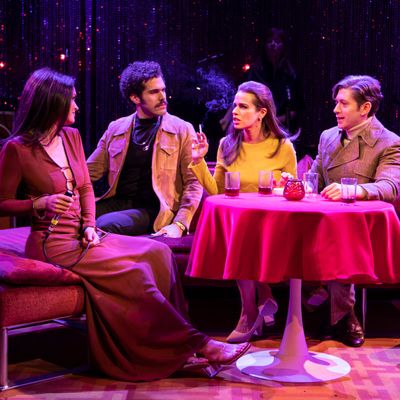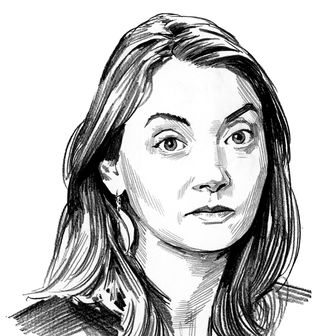
In 1969, Paul Mazursky’s movie Bob & Carol & Ted & Alice was a runaway hit. It was a naughty, playful film about the sexual revolution — or at least the glossy, Hollywoodified version of it. Once the Haight-Ashbury revelations about evolved consciousness and open relationships dawned on the moneyed classes, people dared to ask: Could an anti-capitalist, anti-patriarchal, anti-repression free-love movement work for rich guys and their country-club wives? Baby, could it ever.
Flash forward 30 years, and the playwright Jonathan Marc Sherman, composer-lyricist Duncan Sheik, and lyricist Amanda Green have wrestled Bob & Carol & Ted & Alice onto a stage and made it a musical for the New Group. Much of the original plot is there. Married couple Bob (Joél Pérez) and Carol (Jennifer Damiano) have a spiritual breakthrough at a 24-hour Human Potential encounter group, where they discover something about their love. Staring deep into each other’s eyes, they see vulnerability and permission. Carol tries to explain: “Bob, it’s where we’re at. It’s how we feel. It’s true.” At dinner, they try to convey this triumph of the feel to Ted (Michael Zegen) and Alice (Ana Nogueira), who balk. It’s only after they see the new paradigm in action — Carol rolls with Bob’s affair, Bob is chill with Carol’s side piece — that the more uptight couple starts to get with it.
The world has not been clamoring for a musicalization of Mazursky’s film, which has certainly fought the process. First of all, the movie is a comedy very much of its time, and its jokes — about frigid wives and tennis pros and massages at Esalen — seem to be echoing down a long tunnel. Second, the film capitalizes over and over on the frightened thrill in a character’s eye as each sexual-repression barrier blows up, and the theatrical creative team has not found a way — musical or otherwise — to “zoom in” to show us those internal earthquakes.
And third, the film already had memorable music. Quincy Jones composed strutting, funky, bass-heavy instrumentals for it, as well as some trippy late-’60s riffs on Handel’s Messiah, which underscored, as it were, the silliness and self-aggrandizement of bourgeois hippies. Erasing good stuff and replacing it with Sheik’s shag-carpet-soft rock isn’t a good trade. It’s not that Sheik’s music is bad, exactly; it’s just deliberately recessive, so floaty and spacey that it turns into wallpaper.
Finally, even if you’ve only got a fading memory of the movie, you might remember its best-known sequence. At the end of the film, after an anticlimactic (hello!) orgy, the smug foursome stride out of their hotel as Burt Bacharach’s “What the World Needs Now” plays on a seemingly eternal loop. The song keeps getting louder as dozens of random couples join the hero quartet, and the group all wanders dazedly around a Las Vegas parking lot. It’s … peculiar. The people seem like animals loosed from a Noah’s Ark/cruise ship, first marching two-by-two, then slowly sniffing one another out in a groovy, baby kind of way. I have been helplessly singing “What the World Needs Now” since I saw the movie last week; in fact, Bacharach’s tune is overwriting the Sheik and Green songs even as I try to recall them. To adapt a work that has such a core relationship with a piece of music and to replace the tune is chutzpah; to try snuffing out the music industry’s earwormiest earworm is frankly self-sabotage.
Certainly, despite Scott Elliott’s typically careful direction, there is a sizzle of instability in the air. A little over a week before their first performance, the creators announced that the Band Leader, the narrator who reads a variety of roles from the band’s little platform in the back, would be recast, from the composer-creator Duncan Sheik to Suzanne Vega. Sheik issued a calm statement about juggling too many balls or wearing too many hats, but that’s a big change to make so late in the day. With the show’s creator at the mic, it would have felt like a cabaret performer’s set, with his fantasies coming to life around him. Would that have been darker and truer? Or simply creepier? Whatever the reason for her late addition, Vega is, at least, suited to the show’s blissed-out-but-instructive vibe. Her voice exists on the shoreline between singing and speaking anyway, so when she drifts out into a song and then back into narration, we barely register the difference. Her slightly awkward, not-an-actor coolness, though, puts the effortful central foursome in stark relief.
Because at the root of all Bob & Carol & Ted & Alice’s problems — beyond the weightlessness of its stakes-free plot, beyond the vague language, beyond the limp jokes — is its failure to create any kind of erotic atmosphere. The actors tell each other how horny they are as they change into costume designer Jeff Mahshie’s revealing dresses and cute bathing suits (the women) or Nehru jackets and bead necklaces (the men), yet there’s no flicker, no lust, no zing among them. Zegen, flirting with the audience, does almost manage to create a mood all by himself, but his wicked eye catches its prey in the front row, not onstage. The rest spend the show clearly ill at ease. Perhaps their discomfort stems from the way that Elliott’s in-the-round environment gives them nowhere to hide. Derek McLane’s set puts us on three sides of the action; the band at their keyboards and drums makes up the fourth. Stripping to your underwear in an operating theater or in the middle of a stadium isn’t fantasy — it’s the stuff of nightmare. So we watch poor Bob and poor Carol and poor Ted and poor Alice trying desperately to turn one another on. But the show just keeps turning them off.
Bob & Carol & Ted & Alice is at the Pershing Square Signature Center through March 22.





